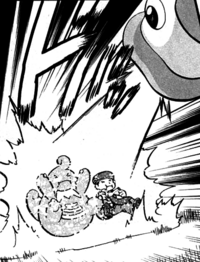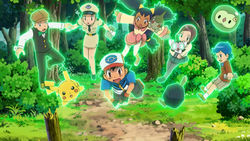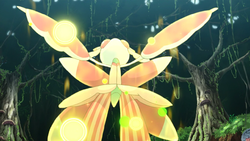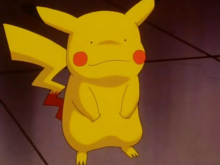Status condition: Difference between revisions
(dusruption link) |
m (→Pokémon Shuffle: typo) |
||
| Line 669: | Line 669: | ||
The effects of Shuffle's status conditions are as follows: | The effects of Shuffle's status conditions are as follows: | ||
* '''Asleep''' - The Pokémon cannot use [[ | * '''Asleep''' - The Pokémon cannot use [[disruption]]s, their disruption countdown is paused, and the Pokémon will take 20% more damage. Caused by the Skills {{DL|Skill (Shuffle)|Nap Time}} or {{DL|Skill (Shuffle)|Sleep Charm}}. | ||
* '''Burned''' - The Pokémon takes 50% more damage from {{t|Fire}}-type Pokémon. Caused by the Skills {{DL|Skill (Shuffle)|Burn}} or {{DL|Skill (Shuffle)|Burn+}}. | * '''Burned''' - The Pokémon takes 50% more damage from {{t|Fire}}-type Pokémon. Caused by the Skills {{DL|Skill (Shuffle)|Burn}} or {{DL|Skill (Shuffle)|Burn+}}. | ||
* '''Disruption Delay''' - The Pokémon cannot use disruptions, and their disruption countdown is paused. This is inflicted by the [[File:Disruption Delay.png|20px|link=]] Disruption Delay item, as well as the Skills {{DL|Skill (Shuffle)|Astonish}}, {{DL|Skill (Shuffle)|Chill}}, {{DL|Skill (Shuffle)|Constrict}}, {{DL|Skill (Shuffle)|Crushing Step}}, {{DL|Skill (Shuffle)|Daunt}}, {{DL|Skill (Shuffle)|Fascinate}}, {{DL|Skill (Shuffle)|Flap}}, {{DL|Skill (Shuffle)|Sand Sport}}, or {{DL|Skill (Shuffle)|Whirlpool}}. | * '''Disruption Delay''' - The Pokémon cannot use disruptions, and their disruption countdown is paused. This is inflicted by the [[File:Disruption Delay.png|20px|link=]] Disruption Delay item, as well as the Skills {{DL|Skill (Shuffle)|Astonish}}, {{DL|Skill (Shuffle)|Chill}}, {{DL|Skill (Shuffle)|Constrict}}, {{DL|Skill (Shuffle)|Crushing Step}}, {{DL|Skill (Shuffle)|Daunt}}, {{DL|Skill (Shuffle)|Fascinate}}, {{DL|Skill (Shuffle)|Flap}}, {{DL|Skill (Shuffle)|Sand Sport}}, or {{DL|Skill (Shuffle)|Whirlpool}}. | ||
Revision as of 07:41, 28 August 2023
- Status redirects here. For the move category, see status move.

|
This article is incomplete. Please feel free to edit this article to add missing information and complete it. Reason: Missing some volatile status conditions |

|
The contents of this article have been suggested to be split into Status condition and Volatile status condition. Please discuss it on the talk page for this article. |
Status conditions (Japanese: 状態異常 abnormal condition), also referred to as status problems or status ailments, affect a Pokémon's ability to battle. There are three kinds of status. The first are non-volatile, the second are volatile, and the third lasts while a Pokémon is in battle. The Pokérus is a similar but unrelated concept.
In the core series and side series
Non-volatile status
A non-volatile status condition is a status condition that remains after being switched out. It's displayed in the party screen, and the Pokémon's summary. They can be cured by healing at a Pokémon Center, specific curative items, or other ways. If a Pokémon is affected by a non-volatile status condition, an icon will display the type of status condition (replacing the Pokémon's level in Generations I and II). Wild Pokémon that are affected by a status condition are easier to catch.
A Pokémon cannot gain non-volatile status conditions when it is affected by Safeguard, Leaf Guard, Flower Veil, Shields Down, Comatose, or Misty Terrain, nor can a Pokémon behind a substitute gain status conditions, except due to Synchronize, Rest, or a held item like Flame Orb or Toxic Orb. A Pokémon will cure its status condition when affected by Haze (Generation I only), Rest, Refresh, Heal Bell, Aromatherapy, Psycho Shift, Jungle Healing, G-Max Sweetness, Natural Cure, Purify, Take Heart, Lunar Blessing, Shed Skin, Healer, Hydration, or Lum Berry. Player can cure any status condition of their Pokémon by using on it any of the following items: Full Heal, Full Restore, Heal Powder, Pewter Crunchies, Rage Candy Bar, Lava Cookie, Old Gateau, Jubilife Muffin, Casteliacone, Lumiose Galette, Shalour Sable, Big Malasada, Sacred Ash, or Lum Berry (MiracleBerry in Generation II).
Pokémon with Guts, Marvel Scale, or Quick Feet will have their Attack, Defense, or Speed increased, respectively, when affected by a status condition. In addition, the base power of Facade is doubled (from 70 to 140) when inflicted with paralysis, a burn, or poison.
In all games except Pokémon Legends: Arceus, a Pokémon cannot gain a non-volatile status condition if it's already afflicted by another one, and a non-volatile status condition does not wear off automatically when the battle ends. If a Pokémon under a status condition (such as a poisoned Cascoon) evolves, the condition will be kept, even if the Pokémon gains a new type or Ability that would normally prevent it.
In Pokémon Legends: Arceus, all non-volatile status conditions have a set turn count and wear off after battle. If a Pokémon already has a non-volatile status condition, inflicting it with another one can override it.
Burn

- Main article: Burn (status condition)
The burn condition (BRN) inflicts damage every turn and halves damage dealt by a Pokémon's physical moves (except Pokémon with the Guts Ability and Facade from Generation VI onward). In Generation I and from Generation VII onward, burn inflicts damage equal to 1/16 of its maximum HP every turn; from Generation II to VI, burn inflicts damage equal to 1/8 of its maximum HP every turn. Burn damage is halved if the Pokémon has the Ability Heatproof. In Generation V, Pokémon glow red while afflicted with burn.
Most moves which cause burn are Fire-type and burning the prime effect of Will-O-Wisp, however it also can be caused by the ability Flame Body or holding a Flame Orb. In Generations I and II, Fire-type Pokémon cannot be burned by Fire-type moves (but they can be burned by Tri Attack in Generation II). From Generation III onward, Fire-type Pokémon and Pokémon with the Water Veil or Water Bubble Ability cannot normally be burned. Pokémon with the Ability Heatproof will only lose half the HP each turn, while Pokémon with Magic Guard are immune to the HP loss (but still suffer from the attack drop). Pokémon with Flare Boost will have their Special Attack increased when burned. A burn can be cured with the use of a Burn Heal, Yago Berry (Generation III only), or a Rawst Berry (Ice Berry in Generation II).
In Generations I and II, burn damage is applied after the Pokémon takes its turn, but is skipped if the opponent faints during that turn. From Generation III onward, burn damage is applied after all Pokémon on the field have taken their turns (and there is no skipping).
Freeze
- Main article: Freeze (status condition)
The freeze condition (FRZ) causes a Pokémon to be unable to use moves. From Generation II onward, the frozen Pokémon has a chance to be thawed each turn (10% in Generation II or 20% in Generation III onwards), possibly even thawing right after being frozen; however, in Generation I, a frozen Pokémon never thaws without external aid. Pokémon cannot be frozen in harsh sunlight.
All moves which cause freezing are Ice-type, except Tri Attack (Generation II onward), Secret Power (when used in snow or ice; Generation IV onward) and Freezing Glare. In Generations I and II, Ice-type Pokémon cannot be frozen by Ice-type moves (but they can be frozen by Tri Attack in Generation II). From Generation III onward, Ice-type Pokémon and Pokémon with the Magma Armor Ability cannot normally be frozen. Being frozen can be cured with the use of an Ice Heal, a Aspear Berry (Burnt Berry in Generation II) or Pumkin Berry (Generation III only).
A frozen Pokémon can still use the moves Fusion Flare, Flame Wheel, Sacred Fire, Flare Blitz, Scald, and Steam Eruption while frozen; these moves will thaw the user and be executed normally. In Generation V, Pokémon glow blue and stop moving while afflicted with freeze. If a frozen Pokémon is hit by a damaging Fire-type move (except Fire Spin in Generations I and II or Hidden Power in Generations II and III), Scald (Generation VI onward) or Steam Eruption, it will be thawed.
Frostbite
Frostbite is a status condition exclusive to Pokémon Legends: Arceus, replacing the freeze condition. Similar to a burn, frostbite inflicts damage equal to 1/16 of the target's maximum HP every turn, and it reduces damage dealt by its special moves during this time. When it is snowing, moves that may inflict frostbite are more likely to do so. Ice-type Pokémon cannot get frostbite.
Using Flame Wheel or Flare Blitz will cure the user of frostbite.
|
Paralysis
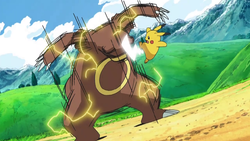
- Main article: Paralysis (status condition)
The paralysis condition (PAR) reduces the Pokémon's Speed stat and causes it to have a 25% chance of being unable to use a move ("fully paralyzed") when trying to use one. From Generation I to VI, its Speed is reduced to 25% of its normal value. From Generation VII onward, its Speed is reduced to 50% of its normal value. Pokémon with the Quick Feet Ability instead have their Speed increased by 50% while paralyzed. In Generation V, Pokémon glow yellow while afflicted with paralysis and their animation will be slowed significantly.
Many moves that cause paralysis are Electric-type moves and paralysis is the main effect of the move Thunder Wave. It can also be caused by Static, Effect Spore, or Gulp Missile. In Generation I, Pokémon cannot be paralyzed by damaging moves of the same type as themselves. From Generation VI onward, Electric-type Pokémon cannot be paralyzed. Pokémon with the Limber Ability cannot normally be paralyzed. Furthermore, if its target is paralyzed, Smelling Salts will cure the paralysis in addition to becoming more powerful. Paralysis can be cured with the use of a Paralyze Heal or a Cheri Berry (PRZCureBerry in Generation II). In Generation IV only, the Ability Magic Guard will prevent Pokémon from being fully paralyzed; however, it does not prevent the Speed reduction.
Poison

- Main article: Poison (status condition)
The poison condition (PSN) inflicts damage every turn. In Generation I, poison inflicts damage equal to 1/16 of its maximum HP every turn; from Generation II onward, it inflicts damage equal to 1/8 of its maximum HP. A Pokémon with the Poison Heal Ability will restore an equivalent amount of HP instead of taking damage. In Generation V, Pokémon glow purple while afflicted with poison.
All moves which cause poison are Poison-type, except Twineedle, Secret Power (when used in tall grass; Generation III only), Psycho Shift (while poisoned), and Fling (if Poison Barb or Toxic Orb is held). Poison-type Pokémon cannot be normally poisoned. The other causes of poisoning are one layer of Toxic Spikes, Poison Point, Effect Spore, or Poison Touch. In Generation II, Steel-type Pokémon cannot be poisoned by Poison-type moves (but they can be poisoned by Twineedle); from Generation III onward, Steel-type Pokémon and Pokémon with the Immunity Ability cannot normally be poisoned. Poison- and Steel-type Pokémon can be poisoned by a Pokémon with the Corrosion Ability. Poison (including bad poison) can be cured with the use of an Antidote, Drash Berry (Generation III only) and Pecha Berry (PSNCureBerry in Generation II).
In Generations I and II, poison damage is applied after the Pokémon takes its turn, but is skipped if the opponent faints during that turn. From Generation III onward, poison damage is applied after all Pokémon on the field have taken their turns (and there is no skipping).
Prior to Generation V, a poisoned Pokémon loses 1 HP for every four steps taken outside of battle. In Generation IV, a Pokémon whose HP is reduced to 1 via poison outside of battle will have the poison status removed; in Generations I, II, and III, its HP will be reduced to 0 (causing it to faint).
Badly poisoned
The bad poison condition inflicts damage every turn, with the amount of damage increasing each turn. It initially inflicts damage equal to 1/16 of the Pokémon's maximum HP, with the damage inflicted increasing by 1/16 each turn (2/16 on the second turn, 3/16 on the third turn, etc.). In Generation V, Pokémon glow purple while afflicted with bad poison. Starting from Generation V bad poison is also marked by darker status flag in the battle and Pokémon summary.
In Generations I and II, if a badly poisoned Pokémon is switched out, the condition reverts to regular poison. From Generation III onward, the poison remains bad poison while switched out, but the damage counter will be reset when switched back in (i.e. it always will take 1/16 of its maximum HP as damage after switching in). In Generations I, II, and from Generation V onwards, after a battle is over, the badly poisoned status will become a regular poison. Bad poison can be cured by the same ways the regular poison is.
All moves which badly poison are Poison-type, except Psycho Shift (while badly poisoned) and Fling (if Toxic Orb is held). Badly poison is the main effect of the move Toxic and two layers of Toxic Spikes.
Sleep

- Main article: Sleep (status condition)
The sleep condition (SLP) causes a Pokémon to be unable to use moves, except Snore and Sleep Talk. From Generation V onward, Pokémon close their eyes while sleeping and move more slowly.
Sleep lasts for a randomly chosen duration of 1 to 7 turns in the handheld Generation I games, 1 to 3 turns in Pokémon Stadium, 1 to 5 turns in Generations II to IV (except the Japanese versions of Pokémon Diamond and Pearl), and 1 to 3 turns in Generation V onwards,[1]. In the Japanese versions of Diamond and Pearl, the minimum and maximum sleep count is 1 turn higher, lasting 2 to 6 turns.[2] If a Pokémon puts itself to sleep using Rest, it will sleep for exactly 2 turns.
Plenty of moves are able to put a Pokémon to sleep, most of them are either Normal-type, Psychic-type, or Grass-type. In addition to moves that cause sleep, after contact with Effect Spore or a disobedient Pokémon may also nap during battle. Pokémon with the Vital Spirit or Insomnia Ability cannot normally be put to sleep. Worry Seed changes the target's Ability to Insomnia causing it to be unable to sleep too. A sleeping Pokémon can be awoken by an Awakening or a Chesto Berry (Mint Berry in Generation II). If its target is sleeping, Wake-Up Slap will wake it up in addition to becoming more powerful. In Generation I core series games and Pokémon FireRed and LeafGreen, the Poké Flute can be used in battle to wake up a sleeping Pokémon (without being consumed). In the Generation III and IV core series games and Pokémon Omega Ruby and Alpha Sapphire, the Blue Flute can be used to wake up a sleeping Pokémon (without being consumed).
In Generation I, a Pokémon that wakes up is not able to attack during that same turn; from Generation II onward, a Pokémon can wake up and use a move during the same turn. In Generation V only, a Pokémon's sleep counter is reset to its original amount when switched out; this also applies for self-induced sleep.
Drowsy
- Drowsy redirects here. For the Pokémon, see Drowzee.
Drowsy is a status condition exclusive to Pokémon Legends: Arceus, replacing the sleep condition. It works similarly to paralysis, and may cause the afflicted Pokémon to be unable to move. Drowsy Pokémon also take increased damage from direct attacks. When it is snowing, drowsy Pokémon are more likely to fail to act.
Using Spark, Volt Tackle, or Wild Charge will cure the user of drowsiness. Rest inflicts drowsiness on the user lasting four turns.
|
Volatile status
A volatile status is a status condition that is inflicted by a move or Ability from another Pokémon and will wear off when a Pokémon is switched out of battle or when a battle is over. Many volatile status conditions will also wear off after a number of turns have passed. A Pokémon can be affected by multiple volatile status conditions at a time. A volatile status condition is not indicated by an icon.
Bound
- Main article: Bound
A bound Pokémon takes damage at the end of each turn and cannot switch out or flee.
Can't escape
- Main article: Escape prevention
A Pokémon that can't escape can neither switch out nor flee as long as the Pokémon that trapped it is on the field.
Confusion
- Main article: Confusion (status condition)
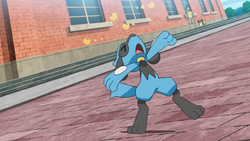
The confused condition causes a Pokémon to sometimes hurt itself in its confusion instead of executing a selected move.
Ability change
- Main article: Ability change
A Pokémon's Ability can be temporarily changed into another one during a Pokémon battle.
Ability suppression
Suppressing Abilities fails if the target's Ability is Multitype, Stance Change, Schooling, Comatose, Shields Down, Disguise, RKS System, Battle Bond, Power Construct, Ice Face, or Gulp Missile. This status is similar to Ignoring Abilities.
Moves
A Pokémon's Ability will be suppressed when hit with any of the following moves.
|
Curse

- Main article: Curse (move)
A cursed Pokémon (affected by Curse used by a Ghost-type Pokémon) takes damage equal to ¼ of its maximum HP every turn.
Drowsy
Yawn and G-Max Snooze makes the target drowsy. At the end of the next turn, the drowsy Pokémon will fall asleep, unless it is already afflicted by a non-volatile status condition. If a drowsy Pokémon switches out, it loses its drowsiness. Drowsiness cannot be passed by Baton Pass.
|
Embargo
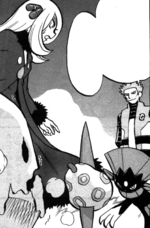
- Main article: Embargo (move)
A Pokémon under the effect of Embargo is unable to use its held item and its Trainer cannot use items on it (including Wonder Launcher items) for five turns. A Pokémon under the effect of Embargo cannot use Fling.
Encore
- Main article: Encore (move)
Encore forces the Pokémon to repeat its last attack for 2-5 turns in Generation II, 4-8 turns in Generations III and IV, and 3 turns in Generation V and VI. In Generation V, if the Pokémon has Magic Coat active, the move will fail.
Flinch

- Main article: Flinch
The flinch status prevents a Pokémon from attacking during one turn.
Grounded
- Main article: Grounded
If a Pokémon is immune to Ground-type moves due to being a Flying type, having Levitate, holding an Air Balloon, or being under the effect of Magnet Rise or Telekinesis, and it is hit by Smack Down or Thousand Arrows, it becomes grounded and loses its immunity to Ground-type moves.
Heal Block

- Main article: Heal Block (move)
- Main article: Psychic Noise (move)
A Pokémon affected by Heal Block or Psychic Noise is prevented from healing for five turns.
Identified
The opponent's evasion modification will not affect the accuracy of a Pokémon that uses Foresight, Odor Sleuth, or Miracle Eye. In addition, a Normal- or Fighting-type move used by a Pokémon that has used Foresight or Odor Sleuth will affect Ghost-type Pokémon, and Psychic-type moves used by a Pokémon that has used Miracle Eye will affect Dark-type Pokémon.
Moves
A Pokémon can be identified when struck by any of the following moves.
|
Infatuation

- Main article: Infatuation
A Pokémon that is infatuated cannot use moves 50% of the time, even against Pokémon other than the one it is infatuated with.
Nightmare
- Main article: Nightmare (move)
Nightmare only affects a sleeping Pokémon. The sleeping Pokémon loses ¼ of its maximum hit points every turn. If the sleeping Pokémon awakens, then the nightmare will no longer be in effect. If Baton Pass switches in a Pokémon that is not asleep (via Sleep Talk), then the nightmare will no longer be in effect.
Perish Song
- Main article: Perish Song (move)
After three turns, all Pokémon who heard the Perish Song will faint, excluding Pokémon with the Soundproof Ability (except in Gen III-VII). Any Pokémon who heard it can avoid the effect of fainting if it is switched out before the three-turn count finishes. Baton Pass transfers the Perish Song countdown. The effect will also take place when Perish Body is activated.
Seeded
- Main article: Seeded
A Pokémon affected by Leech Seed or Sappy Seed loses HP each turn, and the user of that move has its HP healed.
Taunt
- Main article: Taunt (move)
A taunted Pokémon cannot use any status moves for 3 turns (2-4 turns prior to Generation V), including status moves that will always turn into damaging moves like Nature Power. The Taunt status can only be inflicted by the move Taunt.
From Generation V onward, the Mental Herb cures the Pokémon of Taunt. From Generation VI onward, Pokémon with Oblivious are immune to the Taunt condition; if a Pokémon with Oblivious is afflicted by Taunt (such as if it is taunted by a Pokémon with an Ability like Mold Breaker), it will be cured immediately. Pokémon with Aroma Veil and their allies are immune to Taunt.
A taunted Pokémon can still use a status Z-Move.
Telekinesis
- Main article: Telekinesis (move)
A Pokémon levitated by Telekinesis is immune to Ground-type moves, Spikes, Toxic Spikes, and Arena Trap for three turns. In addition, all other moves, except one-hit knockout moves, hit the target regardless of accuracy and evasion; however, it does not allow moves to hit semi-invulnerable Pokémon.
Torment

A tormented Pokémon cannot use the same move twice in a row. If the Pokémon is holding a Choice item or only has one move remaining with PP, it is forced to use Struggle every second turn.
Moves
A Pokémon can be tormented when struck by any of the following moves.
|
Type change
- Main article: Type change
A Pokémon has one or more types temporarily changed, added, or removed in battle.
Splinters
Splinters is a status condition exclusive to Pokémon Legends: Arceus. A Pokémon afflicted with splinters take damage equivalent to a 25-power move from the user, factoring in type effectiveness, but not the random damage factor. Splinters damage the target at the end of its turn, and they last three turns for regular moves, two turns for agile style moves, and four turns for strong style moves.
The moves Ceaseless Edge, Pin Missile, Spikes, Stealth Rock, and Stone Axe inflict splinters onto the target.
Power Boost
This status condition in Legends: Arceus indicates that a Pokémon's offensive stats are raised, increasing the damage it deals with its moves by 50%. It usually consists of moves that can raise Attack or Special Attack in other core series games.
It lasts four turns for Bulk Up, Calm Mind, and Victory Dance and five turns for Nasty Plot and Swords Dance.
Power Drop
This status condition in Legends: Arceus indicates that a Pokémon's offensive stats are lowered, decreasing the damage it deals by a third. It usually consists of moves that can lower Attack or Special Attack in other core series games.
Draco Meteor and Leaf Storm lower the user's offensive stats for three turns. Mystical Fire, Snarl, and Struggle Bug lower the target's offensive stats for three turns, while it lasts five turns for Baby-Doll Eyes.
Guard Boost
This status condition in Legends: Arceus indicates that a Pokémon's defensive stats are raised, decreasing the damage it takes from attacks by a third. It usually consists of moves that can raise Defense or Special Defense in other core series games.
It lasts four turns for Victory Dance and five turns for Iron Defense.
Guard Drop
This status condition in Legends: Arceus indicates that a Pokémon's defensive stats are lowered, increasing the damage it takes from attacks by 50%. It usually consists of moves that can lower Defense or Special Defense in other core series games.
Close Combat and Headlong Rush lower the user's defensive stats for three turns. Triple Arrows lowers the target's defensive stats for three turns.
Critical Hit Boost
This status condition in Legends: Arceus indicates that a Pokémon's critical hit ratio is increased, increasing the chance to land a critical hit.
It lasts 5 turns for Focus Energy and 3 turns for Triple Arrows.
Volatile battle status

|
The contents of this section have been suggested to be split into Battle status. Please discuss it on the talk page for this section. |
A volatile battle status is usually self-inflicted and will wear off when a Pokémon is taken out of battle or a battle is over. Many of these will also wear off after a number of turns pass. Since they aren't shown in battle as a status condition (having an icon) a Pokémon can be affected with multiple volatile battle statuses, volatile conditions and a non-volatile condition at the same time.
Aqua Ring
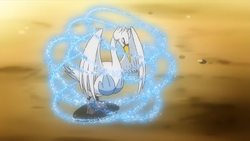
- Main article: Aqua Ring (move)
When a Pokémon surrounds itself with a veil of water by using Aqua Ring, it restores 1/16th of its maximum HP every turn. This effect can be transferred by Baton Pass.
Bracing
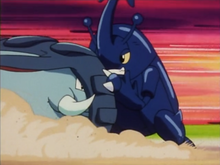
- Main article: Endure (move)
When a Pokémon uses Endure, it braces itself so that whenever it takes damage that turn, it will always survive with at least 1 HP. The Focus Sash, Focus Band, and Ability Sturdy all have similar effects.
Charging turn
Several two-turn moves have a turn where a Pokémon cannot act. The charging can be skipped with a Power Herb, or in the case of Solar Beam and Solar Blade, the presence of harsh sunlight.
Pokémon that are readying Sky Attack become cloaked in light.
Pokémon that are readying Solar Beam or Solar Blade take in sunlight.
Pokémon that are readying Razor Wind whip up a whirlwind.
Moves
A Pokémon can be charging when using any of the following moves.
|
Center of attention

- Main article: Center of attention
If a Pokémon is the center of attention, its opponents are forced to target the center of attention rather than their intended target.
Defense Curl
Using Defense Curl causes the power of Rollout and Ice Ball to double for the Pokémon. This effect is not transferred by Baton Pass.
Rooting
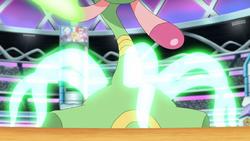
- Main article: Ingrain (move)
When a Pokémon plants its roots by using Ingrain, it restores 1/16th of its maximum HP every turn but cannot switch out or flee, even if hit by a move that would force this such as Roar and Dragon Tail. If a Flying-type Pokémon or a Pokémon with Levitate is rooted to the ground, it is susceptible to Ground-type moves, Spikes and Toxic Spikes. The Pokémon cannot be affected by Magnet Rise and Telekinesis and they are removed if active upon rooting. This effect can be transferred by Baton Pass.
Magic Coat

- Main article: Magic Coat (move)
A Pokémon shrouded with Magic Coat will reflect most status moves used against it or its side of the field back at the user during the turn it used the move. The Ability Magic Bounce reflects the same moves.
Magnetic levitation

- Main article: Magnet Rise (move)
A Pokémon levitating on magnetism via Magnet Rise is immune to Ground-type attacks for five turns. Like Flying-type Pokémon and Pokémon with Levitate, the user is immune to the damage of Spikes and Toxic Spikes, and is unaffected by Arena Trap. Magnet Rise is completely negated by Gravity, Ingrain, and holding an Iron Ball.
This effect can be transferred by Baton Pass.
Mimic
- Main article: Mimic (move)
If a Pokémon uses Mimic, this move will be temporarily replaced by another move copied from the target. In Generation I, the copied move is selected from a list of the opposing Pokémon's moves. From Generation II onwards, Mimic copies the target's last used move.
Minimize
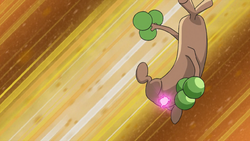
- Main article: Minimize (move)
A Pokémon that has used the move Minimize (or had the effect passed to it via Baton Pass) will be affected more harmfully by some moves, including Stomp, Steamroller, Body Slam, Dragon Rush, Flying Press, and Phantom Force; also in Generation VI, all of these moves will always hit a target that has used Minimize.
Power Trick
Move Power Trick swaps user's base stat of attack with base stat of defense. This effect is passed by Baton Pass.
Protection
- Main article: Protection
A protected Pokémon will be unaffected by both damaging moves and status moves during one turn.
Rampage

- Main article: Rampage
If Pokémon uses either Thrash, Outrage or Petal Dance it will be forced to use that move for 2 or 3 turns (3 or 4 in Generation I) and will get confused at the end.
Recharging

- Main article: Recharge
A Pokémon that successfully uses certain moves must recharge during the next turn. While recharging, the Pokémon cannot perform an action.
Semi-invulnerable turn
- Main article: Semi-invulnerable turn
Several two-turn moves have a turn where a Pokémon becomes semi-invulnerable, and most moves will miss regardless of accuracy, even moves that never miss.
Substitute

- Main article: Substitute (move)
The Pokémon that uses Substitute uses up to ¼ of its total HP (rounded down) to make a substitute which will absorb hits until it "breaks" (damage the substitute has taken is equal to or greater than the HP used to make it).
Taking aim

When a Pokémon uses Mind Reader or Lock-On to take aim at a target, the user's next damage-dealing move will hit that target without fail, even if the opponent uses a move that offers a turn of semi-invulnerability, such as Fly. This effect can be Baton Passed.
Moves
A Pokémon will be taking aim when using any of the following moves.
|
Transformed
- Main article: Transform
A Pokémon is transformed into the target with the use of Transform. Additionally, Imposter (Ditto's signature Ability) automatically causes the user to transform into the opponent.
Fixated
In Pokémon Legends: Arceus, Pokémon can become fixated on using a move. While fixated, that move deals increased damage, but also causes the user to receive increased damage from direct attacks. Fixation ends when the Pokémon uses a different move.
The moves Petal Dance, Outrage, Rollout, Ice Ball, and Raging Fury cause fixation after they are used; additionally, the item Choice Dumpling can cause fixation on the last move used.
Primed
Primed is a status condition exclusive to Pokémon Legends: Arceus that causes the user's attack moves to deal 50% more damage.
The moves Double Hit and Victory Dance prime the user for five and four turns, respectively. Additionally, the item Twice-Spiced Radish primes the Pokémon it is used on.
Obscured
Obscured is a status condition exclusive to Pokémon Legends: Arceus that causes incoming attacks to become more likely to miss. It does not affect sure-hit moves, which will always hit an obscured target regardless. It corresponds to moves that can lower the target's accuracy in other core series games.
Mud Bomb, Mud-Slap, Octazooka, and Shadow Force obscure the user for three turns, while for Lunar Blessing and Shelter, it lasts four turns.
In the spin-off games
Pokémon Mystery Dungeon series
- Main article: Status condition (Mystery Dungeon)
In the Pokémon Mystery Dungeon series, Infatuation prevents the Pokémon from doing anything for 5-6 turns, and causes linked moves to cease.
The Flinch status is known as the Cringe in Pokémon Mystery Dungeon: Red Rescue Team, Blue Rescue Team, Explorers of Time, Explorers of Darkness and Explorers of Sky, and Gates to Infinity. It is renamed as the flinch status condition in Pokémon Super Mystery Dungeon.
Pokémon Conquest
In Pokémon Conquest, all status conditions disappear after battle.
In this game, confusion is a non-volatile status. A confused Pokémon may randomly move and attack other Pokémon, including allies. If a Pokémon moves in its confusion, the Warrior is prevented from using an item or activating a Warrior Skill that turn. Confusion may wear off in the first turn.
In this game, a Pokémon that has flinched is unable to perform any actions (i.e. move around, use moves), along with its partner Warrior (i.e. use Warrior Skills, use items, link). Since battles in this game are turn-based, flinching does not require a first strike via an advantage in Speed or priority, unlike in the main series. The turn-based gameplay and the duration of flinching also makes consecutive flinching impairment impossible, unlike in the main series.
Pokémon Shuffle
In Pokémon Shuffle, all status conditions will wear off as turns pass. Status conditions can be inflicted onto the opponent by Skills when matching Pokémon icons.
The Skill Relentless will increase the damage of combos against a foe that has a status condition.
The Skill Mind Zap cannot activate against a foe that has a status condition.
The effects of Shuffle's status conditions are as follows:
- Asleep - The Pokémon cannot use disruptions, their disruption countdown is paused, and the Pokémon will take 20% more damage. Caused by the Skills Nap Time or Sleep Charm.
- Burned - The Pokémon takes 50% more damage from Fire-type Pokémon. Caused by the Skills Burn or Burn+.
- Disruption Delay - The Pokémon cannot use disruptions, and their disruption countdown is paused. This is inflicted by the
 Disruption Delay item, as well as the Skills Astonish, Chill, Constrict, Crushing Step, Daunt, Fascinate, Flap, Sand Sport, or Whirlpool.
Disruption Delay item, as well as the Skills Astonish, Chill, Constrict, Crushing Step, Daunt, Fascinate, Flap, Sand Sport, or Whirlpool. - Frozen - The Pokémon cannot use disruptions, their disruption countdown is paused, and the Pokémon will take 20% more damage from Ice-type Pokémon. Caused by the Skills Freeze or Freeze+.
- Paralyzed - The Pokémon cannot use disruptions, and their disruption countdown is paused. Caused by the Skills Dragon Shriek, Lightning, Paralyze, Paralyze+, Quake, or Shock Attack.
- Poisoned - The Pokémon takes 50% more damage from Poison-type Pokémon (However, the activation move only takes 20% more damage). Caused by the Skill Poison.
- Spooked - The Pokémon takes 50% more damage from Ghost-type Pokémon. Caused by the Skills Spookify or Spookify+.
In this game, most types have immunities to certain status conditions. These listed in the chart below, where an "X" indicates an immunity.
| Status condition effectiveness | ||||||||||||||||||
|---|---|---|---|---|---|---|---|---|---|---|---|---|---|---|---|---|---|---|
| Condition | Defender's type | |||||||||||||||||
| Asleep | ✘ | ✘ | ✘ | ✘ | ✘ | ✘ | ✘ | ✘ | ||||||||||
| Burned | ✘ | ✘ | ✘ | ✘ | ✘ | ✘ | ✘ | |||||||||||
| Frozen | ✘ | ✘ | ✘ | ✘ | ✘ | ✘ | ✘ | ✘ | ✘ | |||||||||
| Paralyzed | ✘ | ✘ | ✘ | ✘ | ✘ | ✘ | ✘ | ✘ | ||||||||||
| Poisoned | ✘ | ✘ | ✘ | ✘ | ✘ | ✘ | ✘ | ✘ | ✘ | ✘ | ✘ | ✘ | ||||||
| Spooked | ✘ | ✘ | ✘ | ✘ | ✘ | ✘ | ✘ | ✘ | ✘ | ✘ | ||||||||
In other languages
| ||||||||||||||||||||||||||||||||||||||||||||||||||||
Trivia
- In Pokémon Crystal, a Pokémon will not say its cry if asleep, frozen or fainted.
See also
References
| Status conditions | |||
|---|---|---|---|
| BURN | FREEZE | PARALYSIS | POISON |
| SLEEP | CONFUSION | FLINCH | INFATUATION |
| FAINTING | |||

|
This game mechanic article is part of Project Games, a Bulbapedia project that aims to write comprehensive articles on the Pokémon games. |





